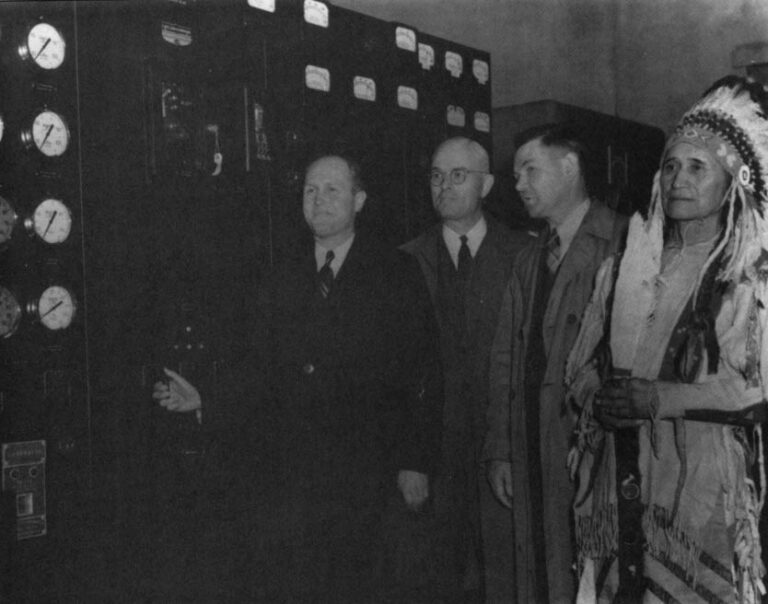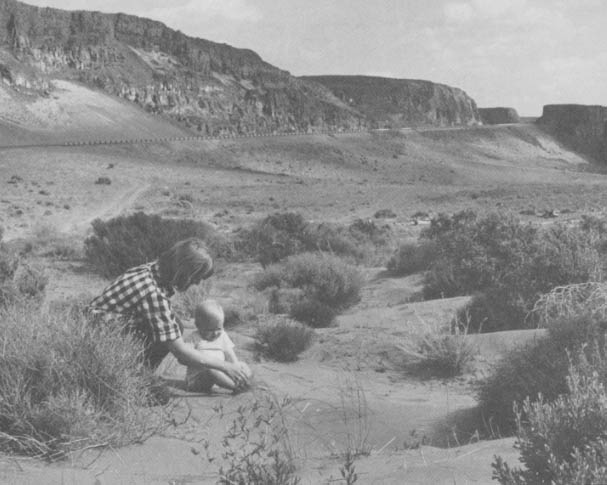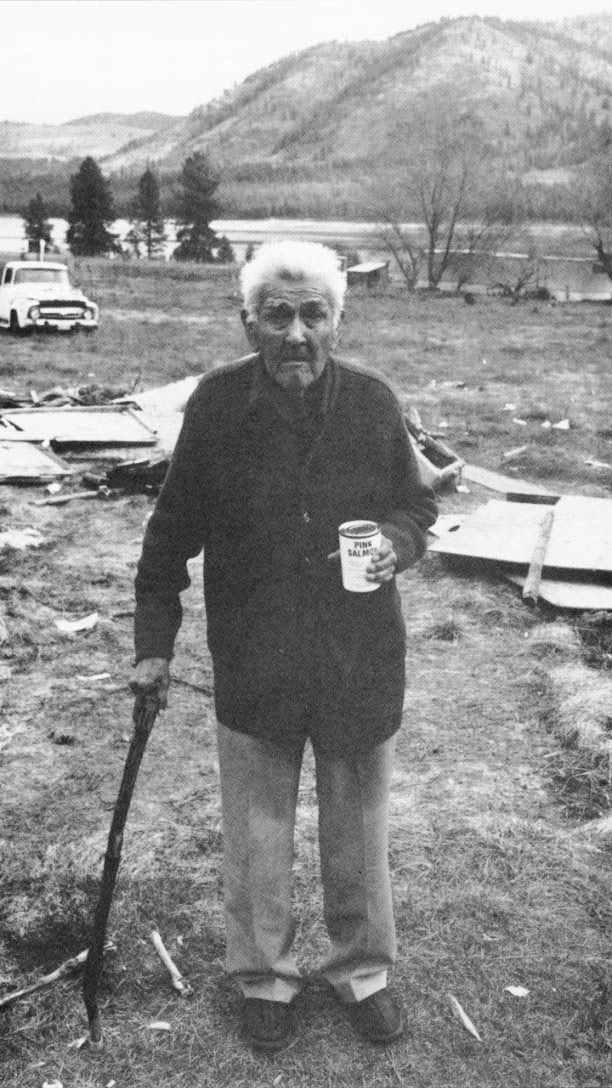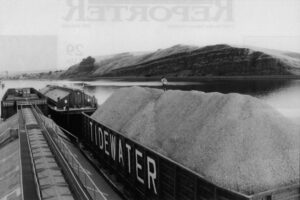COULEE DAM, WASHINGTON – Halfway across a narrow steel bridge over America’s most powerful river, a sign announces the entrance to the Colville Indian Reservation. The sign is small and easily missed in the vast gorge that cradles the roiling Columbia River.
The modest sign poses a question whose answer may come to rattle the most profitable pillar of the federal government’s public-works empire in the West.

Looking just upstream from the steel bridge, the question becomes obvious. For there is the greasy-grey concrete monstrousness of Grand Coulee Dam. It is the largest producer of electricity in the United States, a half-century-old totem of American engineering virtuosity, and the economic cornerstone for nine million people in the Pacific Northwest.
“The mightiest thing ever built by a man,” sang Woody Guthrie, the folk balladeer whom the federal government hired in 1941 to write pro-dam propaganda. Guthrie churned out 26 songs, most of them glorifying a concrete behemoth that bottled tip what he called the “wild and wasted” Columbia.
Praising Grand Coulee Dam was-and remains-easy work. It’s hydroelectricity built ships, airplanes, and atomic bombs that helped win World War 11. The dam seeded the Northwest with aluminum factories and fueled the emergence of the world’s largest airplane-maker, Boeing. It diverted water to create the most elegantly engineered irrigation project in North America.The dam is still the backbone of a regional power-grid that provides the cheapest electricity in the country. Without Grand Coulee Dam it is almost inconceivable that Washington, Oregon, Idaho, Montana and the Canadian province of British Columbia could have been transformed in less than fifty years from a boondock into a booming, high-tech region whose gross national product makes it the 10th largest economy in the world.
Yet the little sign on the steel bridge casts a curious shadow. If the Colville Reservation extends half-way across the Columbia, shouldn’t its members have a claim to power from Grand Coulee Dam? Aren’t the Colville Tribes due a slice of the $412 million worth of electricity that the dam generated last year? Don’t they have, a right to some of the tens of billions of dollars worth of power that the dam has produced in the past five decades?
If the answer to these ownership questions were yes, even a qualified yes, then the Colville Reservation would be home to 7,775 exceedingly well-heeled Indians. For the past half century, however, the federal government’s answer has been a resounding no, and the Native Americans who live on the far side of the steel bridge are about as far from well-heeled as is possible in the prosperous Northwest.

“I attend death scenes on the reservation,” says Allen Nielson, the white prosecutor and coroner for Ferry County, which includes part of the Colville Reservation. “Typically, what I see is a young Indian male with high blood alcohol and perhaps some drugs. He has been suffering from depression and unemployed for some period of time. It is usually a gun shot or a traffic accident. You can take a graduating class at Inchelium High [on the reservation] and in ten years they are all dead. It is absolutely staggering.”
It is only now, in the summer of 1993, that the question raised by the little sign on the bridge is being taken seriously by the U.S. Government. The U.S. Court of Appeals for the Federal Circuit ruled last year that the government has failed to make “fair and honorable dealings” with the Colvilles as regards compensation for power generated on reservation land. It ordered a new trial on the tribes’ claim for a percentage of the dam’s earnings.
Instead of locking horns in a protracted and expensive trial, both the Colvilles and the justice Department have opted, at least for the moment, for a negotiated settlement.
“We want to work this out if possible. We think this should be worked out. I sense that [the lawyer for the Colvilles] is trying to work in good faith with me,” says Glen Goodsell, an attorney for the justice Department.
There is some sympathy in the Clinton Administration toward the Indian’s case, according to a justice Department official, just so long as it doesn’t become a major drain on the federal treasury.

Yet any claim to the 52-year earnings of the Grand Coulee Dam, a facility that generates enough electricity to power four cities the size of Seattle, has the potential to be a major drain.
The Colvilles this spring handed the justice Department a document that demands $1.2 billion in back payments. The bill reportedly stunned and angered government negotiators. The Colvilles, however, say the demand is merely a wake-up call and is negotiable.
“The tribes are willing to forego the greater part of what should have been paid over the years. Instead, we are looking for some reasonable annual payment,” says Harry Sachse, a Washington-based lawyer representing the Colvilles Tribes.
“The people on the reservation have to look at Grand Coulee Dam everyday. When they see it, they shouldn’t just see the destruction of their way of life. They should see something that is doing good things for them as well as for other people in the Pacific Northwest. That is why annual payments are so important.”
“If we go back to court, then of course we will be looking for everything that should have been paid over the years,” Sachse says. “it could be a very large judgment, if we win.”
Tribal leaders are not saying how much they want each year, except that it must be well in excess of the $12.5 million paid annually to Montana’s Crow Indians for Kerr Dam, a relatively small federal project on reservation land.
The solicitor for the Department of Interior wrote in a 1979 letter that it the tribes “could get around the government’s defenses they conceivably could establish a case for 15 to 25 percent of the power of the Grand Coulee…”
That piece of the pie, based on last year’s power generation, would entitle the Colvilles to an annual payment of between $62 and $103 million. That means each member of the Colville Federation could get as much as $13,000 a year.
The Colville demand for recompense could not come at a worse time for the Bonneville Power Administration, the federal agency that markets electricity in the Northwest.
The BPA is in financial disarray, struggling to implement crisis budget cuts and in danger of defaulting on its debts to the U.S. treasury.
“We are dealing with a rather extraordinary set of circumstances,” the BPA:s beleaguered chief, Randy Hardy, told a press conference this spring, as lie tried to explain why his agency is looking at a 20-percent hike this year in electricity rates.
Drought, an unusually cold winter and a slump in aluminum prices (depriving BPA of a third of its revenues) had clobbered the agency, Hardy said.
A quarter of a billion dollars of expected revenue was lost. To make up for missing hydropower, BPA spent four times what it had budgeted to import high-priced electricity from California.
In the past two years, the BPA’s operating reserve has slipped from about $1 billion to less than $90 million. Desperate to save money, the agency has had to give up on two mothballed nuclear reactors, stopping payment on $10 million a year in maintenance costs.
The BPA, however, cannot easily shed its legal obligations to the environment. It is mandated to spend about $260 million a year on fish and wildlife, most of it to protect and revive salmon runs that have been threatened with extinction by hydroelectric dams on the Columbia.
The last thing the BPA needs, in an era when hydropower cannot keep up with energy demands, is a one-time billion dollar Indian claim, and an added obligation of up to $103 million a year. Sonya Baskerville, a lawyer for the BPA in Portland, refuses comment on the Colville case. She say only that her agency is aware of it and “intent on helping justice” to settle the matter.
Before Grand Coulee Dam was completed in 1941, the Confederated Tribes of the Colville Reservation centered their lives around Columbia River salmon. The Colvilles were one of the last Indian groups in the United States whose lives, as of the 1930s, had not been fundamentally changed by whites.
An anthropologist estimated that before the dam was built each tribal member ate one and a quarter pounds of salmon a day. The most sacred ceremonies of Indian life, along with the most intensive season of work, feasting and recreation, revolved around the summer migration of salmon. The biggest and choicest of the salmon were the summer Chinooks.
Whites called them “June Hogs” because they often weighed 60 to 80 pounds. Most of these big salmon were caught in traps in the white-water at Kettle Falls on the Columbia.
Nearly a mile wide, 550-feet high and built with no fish ladders, Grand Coulee Dam blocked all upstream passage of salmon. About 1,400 miles of spawning grounds were lost. Kettle Falls disappeared under Franklin Roosevelt Lake. The dam that the U.S. government paid Woody Guthrie $3,200 to lionize in blue-collar ballads wiped out more salmon than any single structure in American history.
Without salmon, the Colville Tribes fell apart. Rates of suicide, fatal car accidents, alcoholism, drug-addiction, divorce and death by house fire on the reservation soared to levels that stunned a white anthropologist who had studied the Colvilles before the dam. Verne Ray, who lived among the Indians when the salmon were still running, said Grand Coulee Dam “involved a ruthless disregard for Indians as human beings. The result can only be called a disaster for the Colville people.”
The dam pumps water to more than half a million acres in the Columbia Basin Irrigation Project, The entire project lies across the river from the reservation and Indians receive none of the water.The U.S. Bureau of Reclamation has given 4,000 landowners in the project (almost all of whom are white) an infrastructure subsidy of $2.1 million per 960-acre farm. In addition, water for these farms is “virtually free,” according to Jim Cole, who manages the project for the Bureau. Farmers pay just $25 per acre a year for water that, if it were puddled together on a concrete floor, would stand four-feet deep.
As the non-Indian side of the Columbia blossomed, the reservation withered. Drinking water and phone service to some parts of the reservation were cut for 30 years. The dam flooded more than 21,000 acres of prime bottom land, where the bulk of the Indian population had lived for centuries. The best hunting, farming and root-gathering land disappeared. Although they live in the shadow of the big dam, reservation residents pay more than twice as much for electricity as do their neighbors across the Columbia in Grant County. While the Columbia Basin continues to attract new industries (drawn by cheap power and water), unemployment on the reservation has hovered around 50 percent for decades. A chart of income distribution on the reservation shows there is no middle class.

The dismal contrast between Indian penury and white success is on display here in Coulee Dam. A highway winds down into the town from parched reservation land that is littered with wrecked cars and abandoned washing machines. At the city limits of Coulee Dam, which was built by the Bureau of Reclamation and is occupied mostly by white dam workers, rusted junk and blowing dust give way to freshly painted houses, tidy green lawns and the steady stitching of sprinklers.
As part of air after-the-fact environmental impact statement that the Bureau of Reclamation prepared on Grand Coulee Dam in 1975 (42 years after work began on the project), Colville leaders were asked what the dam had done for them. In a statement of sorrow and acid resentment, they said, “tribal members paid with their homes, their lifestyle, their foodstuffs, so that others could have jobs, incomes, and wealth … The Indians are treated as non-persons.”
Out on the Colville Reservation and upstream from Grand Coulee Dam, there is another small and easily missed sign. It lies in the dirt on a hillside just above a ferry landing.
“DRUGS, ALCOHOL, SUICIDE,” the sign says, and it has a drawing of an Indian brave slumped over a horse. The hand-painted sign is on a ranch owned by Martin Louie Sr., an 86-year-old Colville Indian.

Louie is a story-teller, an “informant” for latter-day anthropologists, a sobered up alcoholic and one of the last remaining Colvilles who speared Chinook salmon in the Columbia before the dam. He lives in a leaky camping trailer covered with a blue plastic tarp to keep out the rain.
‘The trailer has a view of what Grand Coulee Dam did to the upper Columbia Basin, mutating a wild river into a placid lake.
“You asking me what did we do after the flood? We, starved. We drank. My daughter-in-law’s son committed suicide. He blowed his brains out about three or four years ago with a rifle. I know two or three who committed suicide,” Louie said.
‘The old mail who has rheumy blue eyes (the legacy of a Welch grandfather who worked for the Hudson’s Bay Company) said the salmon he eats now comes in cans that are part of a federal program for elderly Indians.
Fetching a can of food-aid “PINK SALMON” from a shelf, Louie thrust it in a white visitor’s face.
“You guys took all my food,” the old man said. “This is flow you replaced our salmon.”
©1993 Blaine Harden
Blaine Harden, on leave from The Washington Post’s foreign staff, is examining the Columbia River.




